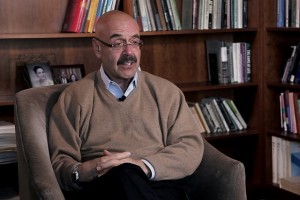Causal Analysis of Non-Experimental Data
Sociologist Christopher WInship on causal effect, observational data, and potential outcomes
In my work I’m interested in thinking about how the socialist city is not necessarily something, which is cease to exist, but something, which is very much still with us today. I’m interested in thinking through my own research, which is partly ethnographic. I’m an anthropologist, so I carry out fieldwork on the city today. I also use history. I’m also partly a historian, a sort of amateur historian and a professional anthropologist. I also look at archives and look into the past of the socialist city itself. I’m mostly interested in finding the remnants of the socialist city in today’s cities, in the cities of today’s Eastern Europe, but also perhaps to some extent in global cities and cities all over the world.
Thinking about how the socialist city as an aesthetic, as an urban morphology, as a way of living your everyday social life in the city, exists not only in Eastern Europe, but also potentially can be said to exist in London and Berlin, in Washington DC, wherever. I’m interested in thinking about the socialist city through the lens of a couple of ideas, which question some of the ways in which we talk about the socialist city as being something that no longer exists.
The idea of the post-socialist city and the idea of post-socialism in general implies that we’ve moved beyond socialism, and that socialism has is something, which belongs only to the past. Whereas I’m interested in developing other ideas, which are more useful for thinking about how the socialist city continues to be with us today.
A lot of scholars of Eastern European architecture and of Eastern European or post-socialist cities have tended to talk about socialist cities as if they were failures, as if they were complete and utter miserable abject failures. The received idea. There’s a sort of fascination with this idea in the literature, but also in a popular culture to do with with socialist architecture and with social cities – is that socialism fell apart and together with the socialist regimes also the architecture and the urban fabrics of these regimes crumbled and fell apart, and the left behind a bleak wasteland, a gray bleak empty wasteland, where all you have are crumbling blocks and an infrastructure, which no longer works and poor unhappy people going about their daily drudgery.
There’s this assumption in a lot of the literature and also in these coffee table books that you have published about the socialist city. If you go to a bookshop in New York, or in London, also into the garage bookshop in Moscow, you’ll find series of very beautifully produced expensive coffee table books devoted to these beautiful ruins. This sort of eroticized fascination with these ruins of socialism, which present an image of socialism as something which architecturally is frozen in time, or all has fallen apart completely and utterly, as if it were some sort of lost Empire.
Within the scholarship in particular there’s a strange tension between several different narratives, and how it was that the socialist city failed, and why it failed. There are some scholars, who emphasize that the socialist city failed because in the view of some of these scholars socialist cities and socialist architecture were too focused on economics, that in a way the socialist city was too Marxist, it was too obsessed with industry, it was obsessed with production, it was obsessed with factories.
The way, in which these socialist cities, these monotowns, these industrial monotowns, but also more generally social cities were built, left no room for cultural life, left no room for the pleasures of urban existence, left no room for unexpected serendipity and spontaneity. People in socialist cities were reduced to being these kind of industrial robots, who are dehumanized by their presence in these cities, by their life in these cities.
For example, if you read Stephen Cochrane’s book on Magnitogorsk, which was published in the 1990s he talks about how the socialist city became an adjunct to industry. If you watch a film like Balabanov’s Cargo 200, you also see this image of daily life as being this completely obscene, living itself out obscenely and to do it in a dehumanized way in the shadow of terrifying foreboding bleak factory.
There was one narrative, which says that the socialist city felt because it was extremely economic, it was too focused on production and in in a way too Marxist, too focused on the economic base as opposed to the culture or ideological, or aesthetic superstructure.
You have this sort of parallel narrative, and these two narratives are quite different, quite difficult to to reconcile with each other, but they are both narratives of the failure of the socialist city.
At a time in which the the infrastructure of the socialist city is becoming increasingly privatized, is becoming increasingly dismantled whether by private developers or by urban authorities, or by national governments, or by whoever, when socialist era housing is being demolished either by developers or for the behest of developers – this is something that’s happening a lot in Moscow, and in all sorts of socialist cities fromWarsaw to Sofia, to Moscow too – the green empty spaces, which socialist planners purposely filled cities in order to provide people with an infrastructure for leisure, these green spaces in between buildings are being filled up with speculatively built office towers or with residential blocks.
At a time when the degradation of what it was made the socialist city an interesting in many ways and problematic place, but in a different kind of urban space (from the urban space of the capitalist world), at a time when this infrastructure and this urban aesthetic is being dismantled, it’s increasingly important to think about how we can actually learn from the the achievements of the socialist city, rather than purely concentrating on its failures, on its perceived or its actual failures.
One example of an actually existing socialist space, which I think functions in a successful, but also in a rather subversive way in the context of the city, in which it’s in now, is the Palace of Culture and Science in Warsaw, which is a two hundred and thirty meter high Stalinist skyscraper, which was gifted to the city of Warsaw by Stalin in 1955 and which was built as a very oppressive structure, which dominates over the cityscape of a city that was destroyed in during the war. When Warsaw was being rebuilt, this vast Stalinist kind of phallic skyscraper was plunked right into the middle of it and the Palace of Culture was perceived by many for a long as a very oppressive thing, which was conceived as a manifestation of Soviet or even perhaps of Russian domination.
It was this strange place, which was simultaneously associated always with oppressive Soviet domination and communist power, not everyone was negatively disposed to, but many people were. At the same time there was always this place of contact with culture, with both a Polish culture, with theater, but also with the only place where you could go to see a famous American jazz musician playing and where you could pick up a book, where the way you could pick up an English language or French language philosophy book. You would go to the Polish Academy of Sciences bookshop to pick that up. It also contained the the Palace of Youth, which was this huge extracurricular center, where the swimming pool and gymnasiums with hundreds of thousands art classes and theater facilities, which hundreds of thousands of Warsaw youths have passed through.
It was a place where there was a huge diversity of public facilities. Now that communism has ended, most of those facilities are still there, and the Palace of Culture still functions as this sort of lively throbbing beehive of social life in a city, which otherwise is being increasingly ruthlessly privatized, in a city where a lot of urban land and a lot of urban infrastructure’s are being given back to private landowners, to property speculators in most cases who are demolishing much of this social infrastructure. In a way the Palace of Culture is a sort of enclaves of still socialist life in the city, which otherwise is being totally and utterly subjected to the sort of degradation, to the privations, which have accompanied the reprivatization of urban life after 1989. In a sense the Palace of Culture can be considered in today’s Warsaw as a sort of an island or as an enclave of still socialist culture, of communists or socialists publicness in a city, which is otherwise being quite ruthlessly subjected to the privatizing and privationary pressures of other kind of lay capitalist urban environment.

Sociologist Christopher WInship on causal effect, observational data, and potential outcomes

Daniel Miller on visual communication, cultural differences in digital behavior, and why people prefer one soc...

Media Scientist Renira Rampazzo Gambarato on three different types of transmedia stories, ‘The Matrix’ and why...